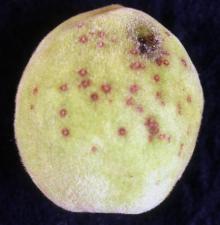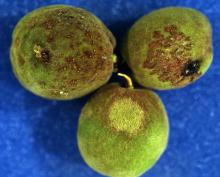Cause Wilsonomyces carpophilus, a fungus that overwinters on infected peach (stone fruit) buds and twigs. When moisture is continuous for at least 24 hours and temperatures are above 36°F, infection can occur in the dormant season. When temperatures are higher during the growing season, shorter periods of moisture are required for germination and infection; for example, only 6 hours are needed at 77°F. Spores spread primarily by splashing water and can remain viable several months when dry. Under favorable conditions, spores can be produced from infected buds and stem lesion throughout the growing season. Most cultivars of peach, nectarine, apricot, and almond appear to be very susceptible. Cherry and plum are less susceptible and show only leaf and fruit symptoms when extended periods of moisture are present in late spring and early summer. Can be a problem in eastern districts when over-the-canopy irrigation is used for frost protection.
Symptoms Leaves develop small, round, tan-to-purplish spots that are seldom larger than 0.25 inch wide. Tissue becomes somewhat raised and scurfy and often drops out in dry, warm weather, producing a shothole effect.
Fruit symptoms are similar and can be accompanied by a clear, gummy exudate. Small red fruit spots may be numerous and slightly sunken. Spots may be confused with peach scab (Venturia carpophila) where small, greenish, circular spots gradually enlarge and deepen in color to black as spore production begins.
On current-season and 1-year-old fruiting wood, infections consist of round, reddish spots, which are slightly sunken. Fruit buds often are killed, and fruiting wood may be badly damaged or girdled. Rough, smoky-appearing cankers up to 2 or 3 inches long develop on 2- to 4-year-old wood. These are a source of the overwintering spores. On apricot, buds often are killed, but very few twig infections occur.
Cultural control
- Do not allow sprinkler irrigation water to wet tree foliage and fruit.
- The cultivars Lovell and Muir are reportedly tolerant.
- Remove affected twigs during pruning if practical.
Chemical control Tank-mix or alternate materials from different groups with different modes of action to prevent fungi from developing resistance. Selection of products for rotation and/or mixing must consider group 7 fungicides when used through the irrigation as a nematicide.
- Spray at 50% leaf fall in late autumn to help protect leaf scars and again during the dormant season.
- Bonide Copper Fungicide at 4.3 to 13 oz/3 to 9 gal water. Group M1 fungicide. H
- Bravo Weather Stik at 3.1 to 4.1 pints/A. Good control rating. Group M5 fungicide. 12-hr reentry.
- Captan 80 WDG at 5 lb/A. Moderate control rating. Group M4 fungicide. 24-hr reentry.
- Copper-based products such as Bordeaux 8-8-100, CS 2005, Cueva, Cuprofix, Kocide, Nordox, Nu-Cop, or Previsto. Good to excellent control rating. Group M1 fungicide. Most with a 48-hr reentry. O
- Echo 720 at 3.1 to 4.1 pints/A. Good control rating. Group M5 fungicide.12-hr reentry.
- Dodine FL at 3 pints/A. Group U12 fungicide. 48-hr reentry.
- Ortho MAX Garden Disease Control at 3.75 teaspoons/ 4 gal water. H
- Monterey Liqui-Cop at 3 to 4 Tbsp/gal water. H
- Syllit FL at 3 pints/A. Group U12 fungicide. 48-hr reentry.
- Ziram 76 DF at 6 to 10 lb/A. Good to excellent rating. Group M3 fungicide. 48-hr reentry.
- Spray again at shuck fall in spring to protect fruit.
- Abound at 12 to 15.5 fl oz/A. Do not apply with silicone-based surfactants. May be applied the day of harvest. Sprayers should not be used on apples. Group 11 fungicide. 4-hr reentry.
- Bonide Fung-onil Multi-purpose Fungicide at 3.75 teaspoons/4 gal water. Group M5 fungicide. H
- Bravo Weather Stik at 3.1 to 4.1 pints/A. Do not apply after shuck split. Group M5 fungicide. 12-hr reentry.
- Captan 80 WDG at 5 lb/A. Good rating when used for same disease on almonds. Group M4 fungicide. 24-hr reentry.
- Cevya at 3 to 5 fl oz/A. May be used day of harvest. Group 3 fungicide. 12-hr reentry.
- Dodine FL at 3 pints/A. Do not apply after petal fall. Group U12 fungicide. 48-hr reentry.
- Echo 720 at 3.1 to 4.1 pints/A. Do not apply after shuck split. Group M5 fungicide. 12-hr reentry.
- Fontelis at 14 to 20 fl oz/A. Can be used day of harvest. Group 7 fungicide. 12-hr reentry.
- Flint Extra at 3 to 3.8 oz/A within 1 day of harvest. 'Concord' grapes may be injured if accidentally sprayed. Group 11 fungicide. 12-hr reentry.
- Inspire Super at 16 to 20 fl oz/A. Do not apply within 2 days of harvest. Group 3 + 9 fungicide. 12-hr reentry.
- Luna Experience at 6 to 10 fl oz/A. May be used day of harvest. Group 3 + 7 fungicide. 12-hr reentry.
- Luna Sensation at 5 to 7.6 fl oz/A. Do not use within 1 day of harvest. Group 7 + 11 fungicide. 12-hr reentry.
- Miravis at 5.1 fl oz/A. Can be used up to the day of harvest. Group 7 fungicide. 12-hr reentry.
- Miravis Duo at 13.6 fl oz/A. Can be used up to the day of harvest. Group 3 + 7 fungicide. 12-hr reentry.
- Pristine at 10.5 to 14.5 oz/A. Can be used day of harvest. Group 7 + 11 fungicide. 12-hr reentry.
- Quadris at 12 to 15.5 fl oz/A. May be applied the day of harvest. Sprayers used for Abound should not be used on apples. Group 11 fungicide. 4-hr reentry.
- Quadris Top at 12 to 14 fl oz/A. May be applied on the day of harvest. Group 3 + 11 fungicide. 12-hr reentry.
- QuiltXcel at 14 fl oz/A. May be applied the day of harvest. Sprayers should not be used on apples. Group 3 + 11 fungicide. 12-hr reentry.
- Rhyme at 7 fl oz/A. Do not use within 7 days of harvest. Group 3 fungicide. 12-hr reentry.
- Spectracide Immunox Multi-Purpose Fungicide Spray Concentrate for Gardens at 0.5 fl oz/gal water. May be applied up to the day of harvest. Do not use more than seven (7) times per season. Group 3 fungicide. H
- Syllit FL at 3 pints/A. Do not apply after petal fall. Group U12 fungicide. 48-hr reentry.
- Tesaris at 3.5 to 5.6 fl oz/A. Do not use with oil-based products. May be used day of harvest. Group 7 fungicide. 12-hr reentry.
- Topguard EQ at 6 to 8 fl oz/A. Do not use with silicone surfactants or within 7 days of harvest. Sprayers should not be used on apples. Group 3 + 11 fungicide. 12-hr reentry.
- Ziram 76 DF at 6 lb/A. Do not apply within 30 days of harvest. Good rating when used for same disease on almonds. Group M3 fungicide. 48-hr reentry.
Notes: Sulfur-based products were ineffective when used for same disease on almonds.
Peach scab has rarely been seen in Oregon. Only two samples have been received by the OSU Plant Clinic from the Willamette Valley and the disease has also been seen on peach in the Medford area and on apricot in the Milton-Freewater area. Many fungicides used for brown rot and shothole at the end of bloom also control peach scab.
References Grove, G.G. 2002. Influence of temperature and wetness period on infection of cherry and peach foliage by Wilsonomyces carpophilus. Canadian Journal of Plant Pathology 24:40-45.
Shaw, D.A., Adaskaveg, J.E., and Ogawa, J.M. 1990. Influence of wetness period and temperature on infection and development of shothole disease of almond caused by Wilsonomyces carpophilus. Phytopathology 80:749-756.







